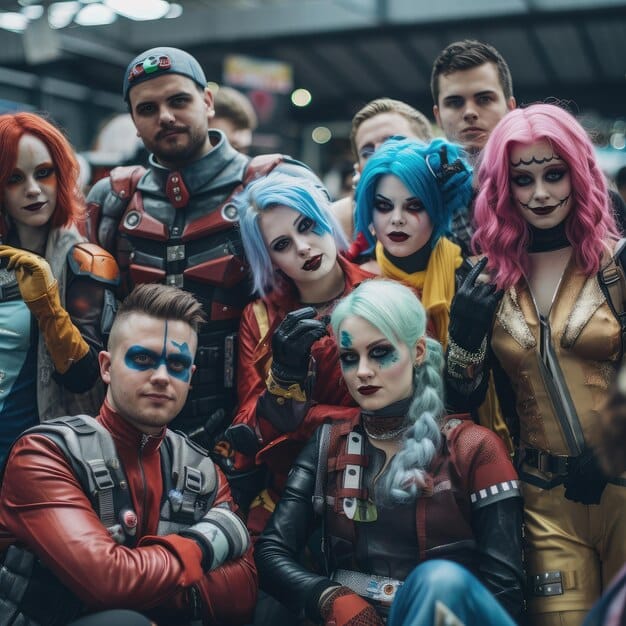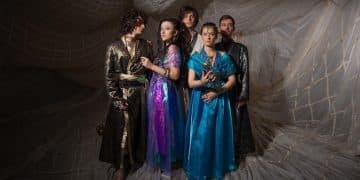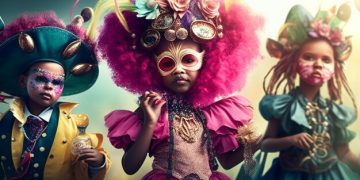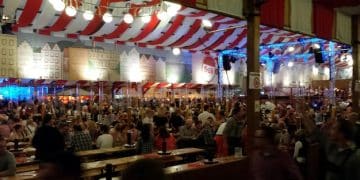Cosplay: More Than Just a Hobby, a Geek Lifestyle Staple

Cosplay is a significant aspect of geek lifestyle, where personal expression and creativity unite, and enthusiasts craft intricate costumes to embody their cherished characters.
Cosplay, or costume play, is more than just dressing up; it’s a vibrant and immersive art form that allows fans to embody their favorite characters from video games, anime, comic books, and more. It has become a cornerstone of geek culture.
What is Cosplay?
Cosplay is a thrilling mix of creativity, craftsmanship, and performance. It’s a way for individuals to express their fandom, transforming themselves into characters they admire. But what exactly does it entail?
Let’s delve into the core elements that define cosplay, from the initial concept to the final reveal.
The Art of Transformation
At its heart, cosplay is about transformation. It involves not only creating a costume but also embodying the character’s personality and mannerisms. This could mean studying their movements, voice, and even their backstory.
More Than Just a Costume
While the costume is a significant part of cosplay, it’s not the only element. Cosplayers often spend countless hours crafting intricate details, from weapons and armor to wigs and makeup, to truly capture the essence of their chosen character.

Here are some key aspects of what makes cosplay so captivating:
- Craftsmanship: A commitment to creating accurate and detailed costumes.
- Performance: Embodying the character’s personality and bringing them to life.
- Community: Connecting with other fans and sharing a passion for cosplay.
Cosplay isn’t just a hobby; it’s a way to connect with others who share your interests and express your love for a particular character or series.
The History of Cosplay
Cosplay’s roots trace back to the science fiction and comic book conventions of the early 20th century. While the term “cosplay” itself wasn’t coined until much later, the spirit of dressing up as fictional characters was already present.
Let’s take a journey through the evolution of cosplay, from its humble beginnings to the global phenomenon it is today.
Early Days and Origins
The first known instance of someone dressing up as a fictional character happened in 1939, when Forrest J Ackerman and Myrtle R. Douglas attended the 1st World Science Fiction Convention in New York, dressed in futuristic costumes. This event is often considered the precursor to modern cosplay.
The Japanese Influence
The term “cosplay” was coined by Japanese journalist Nobuyuki Takahashi in 1984 after attending a science fiction convention in Los Angeles. He was impressed by the elaborate costumes and wanted a term that encompassed the activity. The term quickly gained popularity in Japan and spread throughout the world.

Here are some of the key milestones in the history of cosplay:
- 1939: The first known instance of dressing up as fictional characters at a sci-fi convention.
- 1984: The term “cosplay” is coined in Japan.
- 1990s: Cosplay gains popularity at anime conventions in the United States.
Cosplay has evolved from a niche hobby to a global sensation, embraced by fans of all ages and backgrounds.
The Craftsmanship Behind Cosplay
Creating a cosplay costume is often a labor of love, requiring a wide range of skills and techniques. From sewing and fabric manipulation to armor-making and prop design, cosplayers are constantly learning and honing their craft.
The complexity and artistry that goes into creating these costumes are often overlooked.
Sewing and Fabric Manipulation
Many cosplay costumes involve sewing and fabric manipulation, requiring skills in pattern making, cutting, and stitching. Cosplayers often spend hours researching the best fabrics and techniques to accurately recreate the look of their chosen character.
Armor and Prop Making
For characters with armor or weapons, cosplayers often turn to techniques like foam crafting, 3D printing, and resin casting. These methods allow them to create lightweight yet durable props that look incredibly realistic.
Here are some essential skills that cosplayers often develop:
- Sewing and pattern making.
- Foam crafting and armor construction.
- Wig styling and makeup artistry.
The craftsmanship behind cosplay is a testament to the dedication and creativity of cosplayers worldwide. It’s a constant learning process that challenges their skills and pushes the boundaries of what’s possible.
Cosplay as a Form of Self-Expression
Beyond the craftsmanship and technical skills involved, cosplay is also a powerful form of self-expression. It allows individuals to explore their identity, connect with their passions, and celebrate the characters they love.
It’s about more than just wearing a costume; it’s about expressing who you are.
Connecting with Characters
For many cosplayers, choosing a character to embody is a deeply personal decision. They may be drawn to the character’s personality, backstory, or even their physical appearance. By becoming that character, they can explore aspects of themselves and their identity.
Building Confidence
Cosplay can also be a powerful tool for building confidence. Stepping into the shoes of a beloved character can help individuals overcome insecurities and embrace their unique qualities. The positive feedback and support from the cosplay community can also contribute to a sense of belonging and self-worth.
Here are some ways that cosplay can foster self-expression:
- Exploring different aspects of your personality.
- Connecting with characters you admire and relate to.
- Building confidence and self-esteem.
Cosplay provides a safe and supportive environment for individuals to express themselves and celebrate their passions.
The Cosplay Community
The cosplay community is a vibrant and welcoming space where fans can connect, share their creations, and support one another. Conventions, online forums, and social media groups provide opportunities for cosplayers to meet, collaborate, and learn from each other.
It’s a community built on shared passions and mutual respect.
Conventions and Events
Cosplay conventions are a central part of the cosplay community. These events bring together cosplayers from all over the world, providing opportunities to showcase their costumes, compete in contests, and attend panels and workshops. Conventions are a place where friendships are forged and memories are made.
Online Forums and Social Media
Online forums and social media groups also play a significant role in the cosplay community. These platforms allow cosplayers to share their progress, ask for advice, and connect with others who share their interests. Social media has also helped to elevate the visibility of cosplay, showcasing the talent and creativity of cosplayers to a wider audience.
Here are some benefits of being part of the cosplay community:
- Connecting with other fans and making new friends.
- Sharing your creations and receiving feedback.
- Learning new skills and techniques.
The cosplay community is a supportive and inclusive space where everyone is welcome, regardless of their skill level or background. It’s a place where fans can celebrate their passions and connect with like-minded individuals.
The Future of Cosplay
As technology continues to evolve, the future of cosplay looks brighter than ever. Innovations in 3D printing, wearable technology, and digital design are opening up new possibilities for cosplayers, allowing them to create even more elaborate and realistic costumes.
The future of cosplay is limited only by the imagination.
Technological Advancements
3D printing is already revolutionizing the way cosplayers create props and armor. With access to affordable 3D printers, cosplayers can design and build complex pieces that would have been impossible to create by hand. Wearable technology, such as LED lighting and animatronics, is also becoming more common, allowing cosplayers to add dynamic elements to their costumes.
Expanding Media and Fandoms
As new media and fandoms emerge, cosplay will continue to evolve and adapt. The rise of streaming services and online gaming has created new opportunities for cosplayers to express their love for different characters and series. Cosplay will likely become even more diverse and inclusive as new voices and perspectives are amplified.
Here are some trends that are shaping the future of cosplay:
- Increased use of 3D printing and wearable technology.
- Greater diversity and inclusivity within the community.
- More collaborations between cosplayers and brands.
Cosplay will continue to be a significant part of geek culture for years to come. It will continue to grow and evolve as technology advances and new fandoms emerge.
| Key Aspect | Brief Description |
|---|---|
| 🎭 Transformation | Embodying a character through costume, performance, and mannerisms. |
| 🧵 Craftsmanship | Creating accurate and detailed costumes using various techniques. |
| 🤝 Community | Connecting with other fans and sharing a passion for cosplay. |
FAQ
▼
The term “cosplay” was coined in Japan in 1984 by Nobuyuki Takahashi after he attended a science fiction convention in Los Angeles and was impressed by the elaborate costumes.
▼
Cosplay requires a range of skills, including sewing, fabric manipulation, armor-making, prop design, wig styling, and makeup artistry. Many cosplayers also develop performance skills.
▼
The level of accuracy in cosplay varies from person to person. Some cosplayers strive for perfect accuracy, while others prioritize creativity and self-expression. Ultimately, it comes down to personal preference.
▼
Cosplay conventions are important events for the community, providing opportunities for cosplayers to showcase their costumes, compete in contests, attend panels, and connect with other fans.
▼
Technology is playing a significant role in the future of cosplay, with innovations like 3D printing, wearable technology, and digital design opening up new possibilities for creating elaborate and realistic costumes.
Conclusion
Cosplay is a captivating and ever-evolving art form that embodies the spirit of geek culture. More than just dressing up, it’s a powerful means of self-expression, a celebration of creativity, and a testament to the passion of fans worldwide. As technology advances and new fandoms emerge, cosplay will continue to thrive, bringing people together and inspiring countless individuals to embrace their inner heroes.





